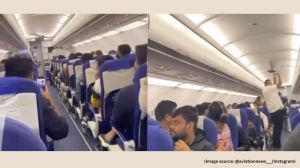Changing versions, contesting claims: How Ishrat encounter refuses to die
The investigation into the encounter soon ran into a cloud of suspicion, and a High Court-appointed Special Investigation Team and the CBI found it to be ‘fake’.
 Ishrat Jahan
Ishrat Jahan
12 years ago, the Gujarat Police shot dead three men and a woman — 19-year-old Ishrat Jahan — allegedly as they headed to Ahmedabad on a Lashkar mission to assassinate Chief Minister Narendra Modi. The investigation into the encounter soon ran into a cloud of suspicion, and a High Court-appointed Special Investigation Team and the CBI found it to be ‘fake’. Along with the Gujarat Police, the CBI implicated the IB in the alleged murders. A new twist to the story was added this week after a Home Ministry official claimed he was forced to file a further affidavit in 2009 that removed references to alleged links between Ishrat and the others and Lashkar, and alleged he had been tortured by an officer who was part of the HC-appointed SIT.
Some milestones on a twisty road:
The case
Ishrat Jahan Raza, 19, along with Javed Shaikh alias Pranesh Pillai, and alleged Pakistanis Amjad Ali Rana and Jishan Johar were shot dead on June 15, 2004, near Kotarpur waterworks outside Ahmedabad. An identity card found on Ishrat identified her as a science student of Guru Nanak Khalsa College in Mumbai.
Watch Video | Ishrat Jahan Fake Encounter Case: All You Need To Know
Gujarat Police claimed to have acted on an intelligence input that Javed was coming with two fidayeens in a blue Indica, MH02 J A 4786, to kill Chief Minister Narendra Modi. As per the FIR of the Ahmedabad City Crime Branch filed that day, the intelligence was received by Ahmedabad Police Commissoner K R Kaushik around end May-beginning June 2004. The FIR named the “two Pakistani fidayeens”, and said “one Javed” who was a resident of Pune, was arranging their local network. It also said Joint Commissioner of Police P P Pandey had received specific information “through his personal source” that a blue Indica had left Mumbai for Ahmedabad with Javed and the “two Pakistani fidayeens”.
The FIR described the operation, and concluded by mentioning “one woman terrorist seated on the seat adjacent to the driver’s seat”, but did not identify her by name.
By then, questions were already being raised about the two other encounters of Samirkhan Pathan (2002) and Sadiq Jamal Mehtar (2003). In August 2004, Ishrat’s mother, Shamima Kauser, filed a petition in Gujarat High Court, seeking a CBI investigation into the alleged fake encounter. In 2007, IPS officers D G Vanzara, Rajkumar Pandian and Dinesh MN (of Rajasthan cadre) were arrested in the Sohrabuddin Sheikh fake encounter case. And in 2009, metropolitan magistrate SP Tamang, who conducted an inquiry into the Ishrat case, concluded it was a fake encounter, and that the four were killed long before they were actually shown as killed.
SIT probe
A special investigation team appointed by the Gujarat High Court, headed by CISF ADGP R R Verma and with Gujarat cadre IPS officers Mohan Jha and Satish Verma as members, found major loopholes in the Crime Branch probe of 2004 conducted by ACP (Women Cell) Parikshita Rathod. Rathod had written to the sub-divisional magistrate mentioning aliases, which, the SIT noted, could not have been known before custodial interrogation or identification. Weapons of the police officers were not forensically examined and logbooks of police vehicles were not checked; the SIT later found no evidence of some police vehicles claimed to have been used.
The intelligence input received by Ahmedabad CP Kaushik had no documentary evidence, and there were variations between the FIR and Rathod’s probe report. Confidential reports prepared in this period indicated that two of the deceased were already in custody before the encounter.
What CBI found
CBI took over the case in 2011, and two years later arrested IPS officers P P Pandey, D G Vanzara, Girish Singhal, DSP Tarun Barot, retired DSP JG Parmar, Inspector Bharat Patel and Barot’s former security commando Anaju Chaudhary, who is from the SRP and was protecting the current Minister of State for Home, Rajnikant Patel, when he was arrested. Singhal, Barot and Chaudhary were released on default bail because the CBI failed to file the chargesheet on time.
The CBI filed two chargesheets against 11 accused in all, of which four were intelligence officials. The 12th accused was commando Mohan Kalasava, who died in 2007. Bharat Patel was not chargesheeted.
It concluded that the “fake encounter was a result of the joint operation of Gujarat Police and SIB (Subsidiary Intelligence Bureau), Amedabad”. The investigation also found that weapons had been sourced from the office of the SIB.The chargesheet says, “That on 14.06.2004, Shri G L Singhal had gone to the office of the SIB as per instructions of Shri D G Vanzara, and had collected weapons in a bag from SIB Office Ahmedabad. He had sent this bag through Shri Nizamuddin Burhanmiyan to Shri Tarun A Barot, who was at Khodiyar Farm.” The SIB then was headed by Rajinder Kumar.
The affidavits
Former undersecretary for internal security at the Home Ministry, RVS Mani, had filed two affidavits in the case before the Gujarat High Court in the space of two months in 2009. The first affidavit claimed that Ishrat and the others were terrorists; the second was silent on this aspect. Mani was questioned by the CBI, assisted by IPS officer Satish Verma in 2013. Mani then complained that “there were differences between the facts in my knowledge and the framing of the same” by Verma, and “many a fact to which I was not privy to or officially never in my domain during the tenure in Ministry of Home Affairs were coerced to be signed by me”. Mani has now claimed that Verma “tortured” him to change his statement.
The Principal Actors: Where Are They Now?
S P TAMANG: Based on scientific evidence including the post mortem report, metropolitan magistrate Tamang refuted in 2009 the Crime Branch claim that Ishrat and others were killed around 3.40 am on June 15, 2004. Javed was killed between 8.30 pm and 9 pm on June 14; others between 11 pm and midnight with unlicensed 9 mm pistol and other weapons, he concluded. Tamang said Javed and Jishan had AK-56 wounds, so they couldn’t have been carrying these weapons, and pointed out other ballistic loopholes that were corroborated by the SIT probe.
#Tamang is now an additional sessions judge on the Una bench of the Junagadh district and sessions court.
SATISH VERMA: The 1986-batch IPS officer who has described the encounter as “pre-meditated murder” to The Indian Express, was denied promotion as ADGP, following which he had moved the Central Administrative Tribunal last year. He has alleged the government “tried to harm him” because of his breakthrough in the Ishrat Jahan case, and protested his posting to NEEPCO, Shillong on central deputation. Verma was a member of the Gujarat HC appointed SIT, and found evidence to question the story of the alleged chase and crossfire between the “LeT terrorists” and police.
#Verma is now Chief Vigilance Officer of NEEPCO in Shillong.
D G Vanzara: Was DCP, Ahmedabad Detection of Crime Branch when the encounter happened. Was arrested in 2007 in the Sohrabuddin Sheikh case, and in 2013 in the Ishrat case. Retired in 2014 while still in jail. Got conditional bail in February 2015.
Rajinder Kumar: Was Joint Director of Subsidiary Intelligence Bureau (SIB), Gujarat. His stint also saw the Sadiq Jamal Mehtar encounter, in which the role of IB officials is under a cloud. He retired as Special Director.
P P Pandey: Heads Gujarat Anti-Corruption Bureau; was promoted as DGP last year after he was bailed out in Ishrat case. Was Vanzara’s immediate superior as Joint Commissioner of DCB when Ishrat was gunned down.
K R Kaushik: Former DGP was Ahmedabad Police Commissioner in 2004. He was named in the FIR lodged by SIT with CBI, but not chargesheeted. Joined Reliance Industries after retirement in 2008, but has now left the company.
G L Singhal: Was Vanzara’s junior in DCB. After release from jail on default bail, was promoted as DIG and is now posted at Gujarat Police Training Academy. Is said to have assisted CBI and given evidence against his own colleagues.
N K Amin: Has MBBS degress; was Assistant Commissioner of Police then; is alleged to have fired 5 rounds from his 9 mm pistol. Is also a key accused in Sohrabuddin encounter case. Now SP of Mahisagar district.
Tarun Barot: Like Vanzara and Singhal, then Police Inspector Barot was an “encounter specialist”. Accused of firing from his service revolver. Retired in jail as a DSP. Also accused in Sadiq Jamal case.
- 01
- 02
- 03
- 04
- 05






































